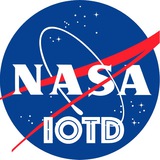The Northrop Grumman Antares rocket, with Cygnus resupply spacecraft onboard, launches from Pad-0A of NASA's Wallops Flight Facility, Saturday, November 2, 2019. http://www.nasa.gov/sites/default/files/thumbnails/image/49002058586_3ad9f42d8c_k.jpg
Orson John helps prepare Ice, Cloud and land Elevation Satellite-2 (ICESat-2) for encapsulation in the United Launch Alliance Delta II payload fairing on Sept. 4, 2018, at Space Launch Complex 2 at Vandenberg Air Force Base in California. http://www.nasa.gov/sites/default/files/thumbnails/image/icesat2closeoutorson.jpg
The U.S. Cygnus space freighter from Northrop Grumman is pictured in the grips of the Canadarm2 robotic arm as it was installed to the Unity module for 70 days of cargo transfers. http://www.nasa.gov/sites/default/files/thumbnails/image/iss061e028414.jpg
This week in 1967, the Apollo 4 mission launched from NASA’s Kennedy Space Center. http://www.nasa.gov/sites/default/files/thumbnails/image/s67-50903_cropped.jpg
A student from Sinte Gleska University works to build a model rover for a NASA Community College Aerospace Scholars. http://www.nasa.gov/sites/default/files/thumbnails/image/rover_0.jpg
The planet Mercury is seen in silhouette, low center, as it transits across the face of the Sun, Monday, Nov. 11, 2019. http://www.nasa.gov/sites/default/files/thumbnails/image/49048341728_21e121889f_o.jpg
Powtawche Valerino is a guidance engineer who works for Aerodyne Industries at the NASA's Marshall Space Flight Center, supporting the agency’s Space Launch System program. http://www.nasa.gov/sites/default/files/thumbnails/image/powtawchevalerino.jpg
Fifty years ago, on Nov. 14, 1969, Apollo 12 launched at 11:22 a.m. EST from Launch Complex 39A at the Kennedy Space Center in Florida. http://www.nasa.gov/sites/default/files/thumbnails/image/s80-37406.jpg
Many galaxies we see through telescopes such as the NASA/ESA Hubble Space Telescope, the source of this beautiful image, look relatively similar: spiraling arms, a glowing center, and a mixture of bright specks of star formation and dark ripples of cosmic dust weaving throughout. This galaxy, a spiral galaxy named NGC 772, is no exception. http://www.nasa.gov/sites/default/files/thumbnails/image/hubble.jpg
Station Commander Luca Parmitano of the European Space Agency conducts repairs, while attached to the Canadarm during the first spacewalk to repair the Alpha Magnetic Spectrometer. http://www.nasa.gov/sites/default/files/thumbnails/image/15november2019spacewalk.jpg
Born and raised in Albuquerque, New Mexico, George Gorospe was taught by his parents to take pride in his Native American heritage. http://www.nasa.gov/sites/default/files/thumbnails/image/acd18-0214-050.jpg
In the Phoenix Constellation, astronomers have confirmed the first example of a galaxy cluster where large numbers of stars are being born at its core. http://www.nasa.gov/sites/default/files/thumbnails/image/phoenix_0.jpg
Eddie Gonzales works to mentor Native American students and others in underserved communities. http://www.nasa.gov/sites/default/files/thumbnails/image/img-2491.jpg
For this image, the NASA/ESA Hubble Space Telescope turned its powerful eye toward an emission-line galaxy called NGC 3749. It lies over 135 million light-years away and is moderately luminous. http://www.nasa.gov/sites/default/files/thumbnails/image/hubble_emitting.jpg
Astronaut Andrew Morgan is tethered to the Starboard-3 truss segment work site during the second spacewalk to repair the International Space Station's cosmic particle detector, the Alpha Magnetic Spectrometer. http://www.nasa.gov/sites/default/files/thumbnails/image/iss061e058236.jpeg
Native American NASA Astronaut, John Herrington is pictured here with Lucasti and Caibiya Tsabetsaye in front of the NASA Artemis banner at the 2019 American Indian Science and Engineering Society’s National Conference. http://www.nasa.gov/sites/default/files/thumbnails/image/john_herrington_artemis_future.jpg
See what the holiday means to NASA’s Christina Koch, Jessica Meir and Andrew Morgan aboard the International Space Station. http://www.nasa.gov/sites/default/files/thumbnails/image/jsc2019m001091_expedition_61_thanksgiving_message_mp4orig.png
Black holes are famous for ripping objects apart, including stars. But now, astronomers have uncovered a black hole that may have sparked the births of stars over a mind-boggling distance, and across multiple galaxies. http://www.nasa.gov/sites/default/files/thumbnails/image/bhfeedback.jpg
Robots need a place to stay in space, too. NASA is attaching a “robot hotel” to the outside of the International Space Station with the upcoming launch of the Robotic Tool Stowage (RiTS). http://www.nasa.gov/sites/default/files/thumbnails/image/rits_in_nbl.png
Within the tempestuous Carina Nebula lies “Mystic Mountain.” http://www.nasa.gov/sites/default/files/thumbnails/image/c92-2.jpg
